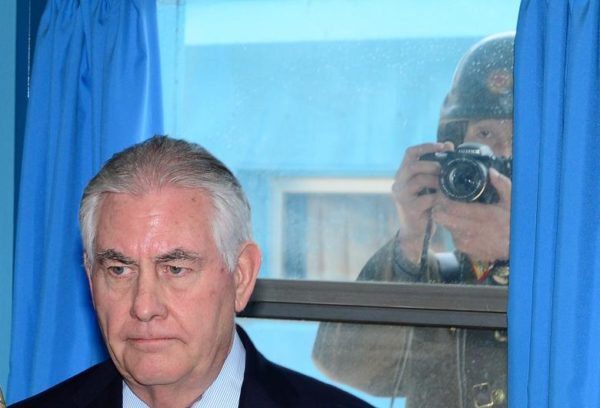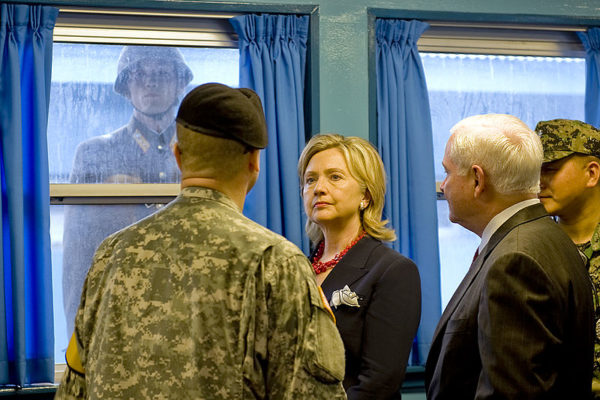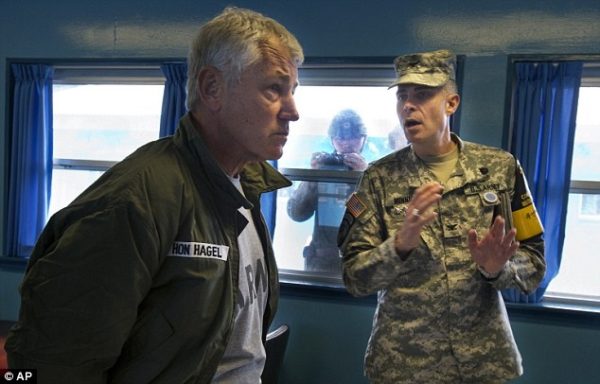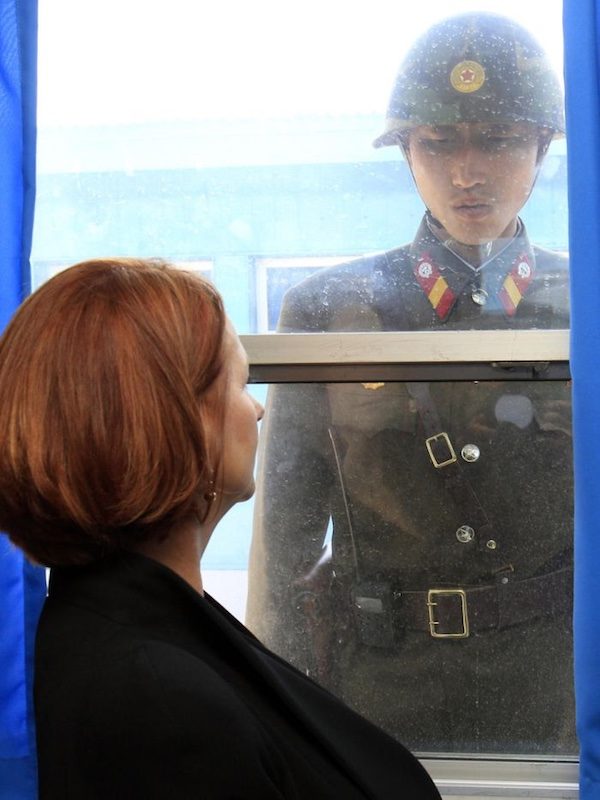Notes
On the Tillerson Photo at the North Korea DMZ

Simply put, you don’t want to be photo bombed, or any other kind of bombed by North Korea. But that’s just a minimum requirement. In the world of international diplomacy, how you handle a photo op when you’re Secretary of State is a basic measure of competence.
With the State Department in deconstruction mode, maybe nobody clued the Secretary about the DMZ hut on the 38th Parallel, the trench line where the Korean War ceasefire was signed in 1953. Maybe he wasn’t prepped, or perhaps he felt he didn’t need to know about the media front, and how North Korean soldiers glare through the window and try and photograph western dignitaries. That’s too bad because the last thing we need to see as Kim Jong Un flaunts his missile program is an American Secretary of State up against the enemy looking that unaware and off guard.
It’s not like there is one way to handle the Hermit Kingdom’s looky-loo challenge. When Hillary Clinton was Secretary of State, for example, she studiously avoided gazing at the window.

Still, looking at this Defense Department photo — and especially, the rest of this Getty edit of her trip to the hut with Defense Secretary Gates — you sense that Clinton is highly aware of what’s behind her, especially as the American military figure is squared off with the North Korean.
Defense Secretary Hagel, on the other hand, gave the North Koreans the outright laser eye in 2013:
Defense Sec Hagel, at the DMZ, eyes two North Korean soldiers eyeing him through the window pic.twitter.com/ar0c5AbIYj
— cbsMcCormick (@cbsMcCormick) September 30, 2013
Hagel might have been camera fodder in the shot below, but unlike Tillerson, Hagel’s tough guy look, the ARMY t-shirt and the fact he’s got a U.S. uniform between himself and the window more than establishes Chuck’s control of the turf.

Or next time, perhaps the tough-talking Tillerson, in the name of his tough-talking boss, might take note of the well-known photo of Australian Prime Minister Julia Gillard eyeballing a North Korean soldier in 2011.

As far as optics go, that is still another way of controlling the setting, and grounding your authority for the folks back home.
Remarkably, and in marked contrast to the others, T Rex manages to make himself the more random and subordinate figure. As a corollary to Trump’s vague policy positions, Tillerson completely fails to situate himself to the threat at hand. Instead, given that the soldier holds a camera to his face, the Secretary literally defaults on a point of view. We know what the North Koreans are about and where they stand. The question that we can’t answer is, who is this Tillerson? What does he wants us to see? And, in the vacuum, how much is he and this administration giving away?
(photo 1: Korea Pool/Yonhap via Reuters. caption: Despite a long list of potential pitfalls, U.S. Secretary of State Rex Tillerson’s visit to China, the first by a senior member of the Trump administration, passed off relatively smoothly although there were no tangible gains to show. No formal agreements were announced in the visit, although the two sides said they would work together on North Korea and countering its rapidly developing nuclear and ballistic missile programs. Wrapped up in the tightly scripted proceedings, however, was a sense that the world’s two biggest economies were warily testing each other out as the new administration settles down in Washington. They seemed to be reserving airing of differences for another occasion. But Tillerson’s diplomatic inexperience showed in at least one instance, when in an interview published on March 18 he appeared to accuse the South Korean government of lying about the details of his visit. Unnamed South Korean officials had told the Korea Herald newspapers that Tillerson’s “fatigue” was to blame for not having a meal with any officials in Seoul, as opposed to his lengthier meetings with Japanese counterparts. Tillerson disputed that in an interview with the Independent Journal Review, a conservative outlet whose reporter was the sole media representative invited to travel with the secretary of state. “They never invited us for dinner, then at the last minute they realized that optically it wasn’t playing very well in public for them, so they put out a statement that we didn’t have dinner because I was tired,” Tillerson said, according to a transcript of the interview. photo 2: DefenseImagery.mil. caption: U.S. Army Col. Kurt Taylor, left, briefs Secretary of State Hillary Rodham Clinton, center, and Secretary of Defense Robert Gates, right, at the truce village of Panmunjom, in a demilitarized zone (DMZ) north of Seoul, South Korea, July 21, 2010, as a North Korean soldier watches through the window. The DMZ has separated North and South Korea since the Korean War. photo 3: AP. caption: Defense Secretary Chuck Hagel’s visit is timed to the 60th anniversary of the signing of the mutual defense treaty between the U.S. and South Korea, September 2013. photo 4: Pool/Lee Jin-Man: AFP. caption: Prime Minister Julia Gillard (left) and a North Korean soldier look at each other through the window of the UN Command Military Armistice Commission meeting room at the border village of Panmunjom in the Demilitarised Zone (DMZ) that separates the two Koreas since the Korean War, April 24, 2011.)


Reactions
Comments Powered by Disqus